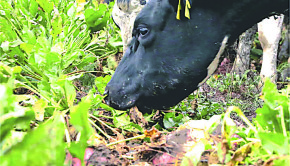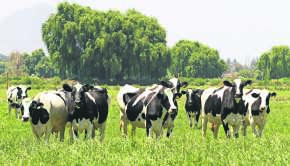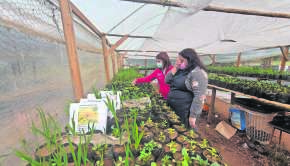biodiversity indices definition
The Pielou index value is defined between 0 and 1. Biodiversity, a multidimensional property of natural systems, is difficult to quantify partly because of the multitude of indices proposed for this purpose. Over the past century, many people have benefited from the conversion of natural ecosystems to agricultural land and from the exploitation of biodiversity. However, this index is also useful to measure the diversity of elements such as schools, places, among others. The two types are: (1) Dominance Indices, and (2) Information-Statistic Indices. Biodiversity is the total variety of life on our planet. the Fair Proportion Index and the Shapley Value (Haake et al. Chapter 7 Alpha diversity. Open Access free for readers, with article processing charges (APC) paid by authors or their institutions. These 50 female led . C) The more species you have, the more diverse the area, right? (A biological community is an interacting group of various species in a common location.) A small sample is used; the index ( D) is the ratio of the number of species to their importance values (e.g. ty | \ b- ()-d-vr-s-t , -d- \ Definition of biodiversity : biological diversity in an environment as indicated by numbers of different species of plants and animals Other Words from biodiversity Did you know? nest shape). Shannon-Wiener Index is defined and given by the following function: H = [ ( p i) l n ( p i)] Where p i = proportion of total sample represented by species i. Divide no. A large proportion of the species waiting to be discovered are in the tropics. The more accurate versions are called the Simpson and Shannon Indexes. Estimates place the global species diversity at several million. The Shannon Diversity Index (sometimes called the Shannon-Wiener Index) is a way to measure the diversity of species in a community. A simple biodiversity index is calculated as follows: number of species in the area total number of individuals in the area = biodiversity index Biological diversity, or biodiversity, refers to the variety of all life on Earthfrom genes to species, ecosystems, and biomes. You may see this equations in exactly the same form, just omitting the 1 -. biodiversity, also called biological diversity, the variety of life found in a place on Earth or, often, the total variety of life on Earth. And people also value nature of itself. Biodiversity is the variety of life at genetic, species and ecosystem levels. Shannon-Wiener index of diversity (information index) A measure used by ecologists when a system contains too many individuals for each to be identified and examined. It includes all living things, not just the plants and animals that are common or easily seen. conservation noun management of a natural resource to prevent exploitation, destruction, or neglect. Alpha diversity. We value biodiversity for many reasons, some utilitarian, some intrinsic. Biodiversity refers to life on land, in the water, in the air, in deserts and caveseven in . The confusion between species diversity and richness is more common than what I had earlier imagined, and I know. Indices of Community Diversity Shannon-Weiner Index of Diversity There are many methods that ecologists use to calculate species diversity. Environment. A widely used dominance index is Simpson's . Species Evenness: a measure of how abundances are distributed among the species. [2], Hartmann [3], Fuchs and Jin [4], Wicke . Biodiversity plays a crucial role in human nutrition through its influence on world food production, as it ensures the sustainable productivity of soils and provides the genetic resources for all crops, livestock, and marine species harvested for food. Biodiversity, or biological diversity, is a term that refers to the number of genes, species, individual organisms within a given species, and biological communities within a defined geographic area, ranging from the smallest ecosystem to the global biosphere. Pielou index is similar with Simpson (1-D) index, which uses the . Biodiversity Assays: Assessment Of Biodiversity, Various species diversity indices and theoretical interpretations Measures of biodiversity at the level of species or populations are directed . Diversity indices provide more information about community composition than simply species richness (i.e., the number of species present); they also take the relative abundances of different Access to a sufficiency of a nutritious variety of food is a fundamental determinant of health. Information is the single most important variable necessary to support research, monitoring and management of alien and invasive species. biosphere noun part of the Earth where life exists. It deals with nature's variety, the biosphere. Comprises two components Species Richness: the number of species in an ecosystem. However, the reliability (and therefore suitability) of these indices for detecting environmental change is . Introduction:A diversity index is a mathematical measure of species diversity in a community. Diversity Indices: A) A diversity index is a mathematical measure of species diversity in a given community. Weeds pose a major threat to world agriculture by reducing detrimentally crop yield and quality. The term "biodiversity" is a contraction of "biological diversity" or "biotic diversity". The value of this index also ranges between 0 and 1. Alpha diversity (-diversity) is defined as the mean diversity of species in different sites or habitats within a local scale. According to IUCN (2004), the total number of plant and animal species described so far is slightly more than 1.5 million. Closely interlinked, biodiversity and ecosystem services support . Area under agricultural practices favorable to biodiversity. [1] Biodiversity contributes directly or indirectly to many aspects of human well-being, for instance by providing raw materials and contributing to health. The activity illustrates how to use math to calculate the diversity index of a selected habitat. Biodiversity is a term which describes every living organism within a single ecosystem or habitat, including numbers and diversity of species and all environmental aspects such as temperature, oxygen and carbon dioxide levels and climate. ecosystem noun However, at the same time, weeds are major interacting components of the agroecosystems. B) Based on the species richness (the number of species present) and species abundance (the number of individuals per species). FAQ Biodiversity is referred to as the various existing within and among the various forms of life on a site, landscape or ecosystem. diversity noun difference. The Shannon diversity index (a.k.a. The word biodiversity is now very widely used not only by the scientific community, but also by the common people . Degree of fragmentation of natural or semi-natural areas. A diversity index is a quantitative measure that reflects how many different types (such as species) there are in a dataset (a community), and that can simultaneously take into account the phylogenetic relations among the individuals distributed among those types, such as richness, divergence or evenness. Definition of SOIL BIODIVERSITY - The WHATThe Convention on Biological Diversity (CBD) defined the soil biodiversity as "the variation in soil life, from genes to communities, and the ecological complexes of which they are part, that is from soil micro-habitats to landscapes".In other terms the soil biodiversity represents the variety of life belowground. Scientists use a formula called the biodiversity index to describe the amount of species diversity in a given area. When the diversity index is zero, the community contains only one species (i.e., no diversity). This means we value biodiversity both for what it provides to humans, and for the value it has in its own right. The total number of races, varieties or species i.e., the sum total of various types of microbes, plants and animals present in a system is referred to as biodiversity. The higher the value, the lower the diversity. The various methods of expressing the level of diversity information measures such as the Shannon-Weaver or Simpson's indices or . Higher numbers of unique taxa, and more even abundance distributions within a sample yield larger values for alpha diversity. The term may also refer to genetic diversity and diversity of habitats or communities. While this year's Gender Diversity Index continues the positive trend already seen in 2020, it is clear that the overall progress is too slow. Each of these species and organisms work together in ecosystems, like an intricate web, to maintain balance and support life. Degree of fragmentation of river ecosystems. Biodiversity is important to most aspects of our lives. Denoted as H, this index is calculated as: H = -pi * ln (pi) where: : A Greek symbol that means "sum". Out of 668 companies, only 50 companies (7%) are led by a female CEO which is an insignificant improvement compared to 42 female CEOs in 2020. Sustainable agriculture is the answer to reverse trends that lead to biodiversity loss. Therefore, such indices need to be treated with caution. It includes all species of animals and plants, and the natural systems that support them. biomass or productivity) within a trophic level or community. Definition. Note: there is a miscalculation in . The Shannon-Weiner Diversity Index is a common way of showing that diversity involves not only numbers of different species, but also how well each of these species is represented in different habitats. Evenness (E) - A measure of how similar the abundances of different species are in the community. ln: Natural log. Using saprobic index (S) and Simpson's diversity index (D) methods have been identified zooplanktons organisms and the number of species, abundance and diversity of distribution patterns. Species richness contributes to biodiversity and is a measurement of the number of species within an ecosystem. D . From identifying and predicting potential invasions to improving management applications, detection strategies, and risk assessments, GBIF plays a pivotal role in fulfilling data needs about these costly and disruptive forces of change. The closer the diversity index is to 1, the more diverse and healthy it is. It is the most complex and important feature of our planet. An equivalent formula is pi: The proportion of the entire community made up of species i. Biodiversity is a measure of variation at the genetic ( genetic variability ), species ( species diversity ), and ecosystem ( ecosystem diversity) level. The Shannon-Weaver diversity index is one widely used index for comparing diversity between various habitats (Clarke and Warwick, 2001).It assumes that individuals are randomly sampled from an independent large population, and all the species are represented in the sample (Shannon and Weaver, 1949).The value of the Shannon-Weaver diversity index usually ranges from 1.5 to 3.5 and only rarely . Chapter 7. [1] Biodiversity is not distributed evenly on Earth, it is usually greater in the tropics as a result of the warm climate and high primary productivity in the region near the equator. Biodiversity. It includes the domesticated plants and animals that are part of crop, livestock, forest or aquaculture . Biodiversity is the variety of all life on Earth. ADVERTISEMENTS: Brief outlines of the two types of diversity indices of biodiversity are discussed in this article. Australia's Strategy for Nature; Biodiversity conservation; Legislation; International role; Science and research. Biodiversity indicators help us measure and monitor a) pressures or threats, such as trends in land and water use, habitat loss or invasive species, b) the state of species and ecosystems, such as the health of species or integrity of ecosystems, c) the conservation response, such as the protection of important biodiversity areas, and/or d) benefits to people, such as the ecosystem services . The index takes into account the number of species living in a habitat (richness) and their relative abundance (evenness). Biodiversity can be termed as and measured like an attribute consisting of two components such as richness and evenness. Since this interpretation is a bit counterintuitive, we often calculate Simpson's Index of Diversity (sometimes called a Dominance Index), which is calculated as 1 - D. Biodiversity - The number of different species of organisms in a particular environment. 1. This is a very simplified version of diversity index. Alpha diversity is a key quantity in a . In particular, for a random sample, we can use Shannon's index of diversity (aka as Shannon-Weiner's index), which is defined as Here, ni is the number of observations from the sample in the ith of k (non-empty) categories and so n = is the sample size. Simpson's Index (D) measures the probability that two individuals randomly selected from a sample will belong to the same species. Diversity Indices Usually used as biodiversity (as in species), but can apply to other data where you count the number of times a particular category occurs (e.g. Diversity indices are commonly used to measure changes in marine benthic communities. biodiversity noun all the different kinds of living organisms within a given area. Environment Biodiversity of India, Biodiversity Hotspots of India. How to Calculate Biodiversity . consumption noun process of using goods and services. Utilitarian values include the many basic needs humans obtain from biodiversity such as food, fuel . Level of social awareness (personnel associated with the project). This section demonstrates the analysis of alpha diversity. CSIRO calculates the BHI from remote sensing data and other studies of ecological diversity. Indices aim to describe general properties of communities that allow us to compare different regions, taxa, and trophic levels. of individuals of species i by total number of samples. It is important to distinguish 'richness' from 'diversity'. The diversity index was calculated by using the Shannon - Wiener diversity index (1949). Diversity is one of the most important parameters used to describe ecosystems. Biodiversity matters because it supports the vital. Shannon-Weiner index (H) - This diversity measure came from information theory and measures the order (or disorder) observed within a particular system. Meaning of biodiversity in English biodiversity noun [ U ] uk / ba..dav.s.ti / us / ba.o.dv.s.ti / the number and types of plants and animals that exist in a particular area or in the world generally, or the problem of protecting this: a new National Biological Survey to protect species habitat and biodiversity In order to evaluate each community's structure and the interactions among them, several population indices are used as key tools. Introduction:A diversity index is a mathematical measure of species diversity in a community. Biodiversity is the diversity of life in a given area and a general indicator of overall ecological health. Evidence about the health of ecosystems is often thought to be related to biodiversity. These terms all refer to the idea of living variation, from genes and traits, to species, and to ecosystems. Such indices (e.g. This word became more meaningful after Edward O. Wilson of Harvard University introduced it in a book entitled. The greater the value, the greater the sample diversity. A diversity index is a quantitative tool used to assess diversity in a specific community. NASA studies how and why global biodiversity is changing, and the effects of these changes on and interactions with Earth's interrelated systems . He Simpson's index it is a formula that is used to measure the diversity of a community. It is just like the radius of a sphere being an index of its volume but not the volume itself! Definition: Biodiversity indices are measures of species diversity expressed as ratios between numbers of species and "importance values" (numbers, biomass, productivity and so on) of individuals. S = number of species, = species richness H m a x = l n ( S) = Maximum diversity possible E = Evenness = H H m a x Biodiversity measures the diversity of life within an ecological system. The basic idea of a biodiversity index is to obtain a quantitative estimate of biological variability in space or in time that can be used to compare biological entities, composed of diverse components. However, these changes have increased . This quantity measures microbial diversity within each sample. Dominance Indices: Dominance indices are weighted toward the abundance of the commonest species. Traditional attempts to define biodiversity consider two components: richnessthe number of species in the ecosystemand evennessthe extent to which species are evenly distributed. Biodiversity for food and agriculture (BFA) is, in turn, the subset of biodiversity that contributes in one way or another to agriculture and food production. Biodiversity describes the richness and variety of life on earth. In this matter, the so-called phylogenetic diversity (Faith [1]) has been introduced as a measure of biodiversity based on the evolutionary history of species. FAO has a long history of fostering sustainable agricultural development and the sustainable use of biodiversity for food and agriculture to pursue its goal of ending poverty and hunger. About Press Copyright Contact us Creators Advertise Developers Terms Privacy Policy & Safety How YouTube works Test new features Press Copyright Contact us Creators . Why is biodiversity important? More Info. It is an application of information theory, and is based on the idea that greater diversity corresponds to greater uncertainty in randomly choosing . Biological diversity (or biodiversity) is the variety of life on Earth. Dimension of direct economic investment in biodiversity. This chapter studies attempts to make both concepts precise using . National framework. 1. As the number of different species increases and the population distribution of species becomes more even, the diversity index increases and approaches one. the Shannon-Wiener index) are generally considered an important means for comparisons of community structure and stability.A different and specialized case of a diversity index is the . Without a wide range of animals, plants and microorganisms, we cannot have the healthy ecosystems that we rely on to provide us with the air we breathe and the food we eat. Ecological footprint of mining activity. Biodiversity is essential for the processes that support all life on Earth, including humans. They are developed by ecologists to examine the number of species in a community and the density of. the Shannon-Wiener diversity index) is a popular metric used in ecology. It is commonly used to measure biodiversity, that is, the diversity of living beings in a given place. Biodiversity is a word recently introduced by experts in the field of biology. This term was coined by Robert Harding Whittaker along with other connected terminologies such as beta diversity (-diversity) and gamma diversity (-diversity). ParaCrawl Corpus Often researchers use the values given by one or more diversity indices, such as species richness, the Shannon index or the Simpson index. Abundance and diversity of weeds vary significantly among the several communities. Diversity indices provide more information about community composition than simply species richness (i.e., the number of species present); they also take the relative abundances of different Photo credit: R. Campbell. It's based on Claude Shannon's formula for entropy and estimates species diversity. Biodiversity is all the different kinds of life you'll find in one areathe variety of animals, plants, fungi, and even microorganisms like bacteria that make up our natural world. It is important in natural as well as artificial ecosystems. 9. The term biodiversity was coined in 1985. It serves as a basis for biodiversity indices used in taxon prioritization, e.g. Diversity indices Last Updated on Wed, 06 Jul 2022 | Species Richness diversity incorporates richness, commonness and rarity An important aspect of community structure is completely ignored, though, when the composition of the community is described simply in terms of the number of species present. A high score indicates high diversity, and a low score indicates low diversity. Biodiversity is the variety of all life forms on earth - the different plants, animals and micro-organisms and the ecosystems of which they are a part. Without biodiversity, life would not sustain. Biodiversity includes genetic, species, community and ecosystem diversity. The popular contraction "biodiversity" came about in the mid-1980s, heralded by a symposium in 1986 and an . Diversity index = H = - Pi In Pi where Pi = S / N S = number of individuals of one species N = total number of all individuals in the sample In = logarithm to base e Measurement of species richness Margalef's index was used as a simple measure of A common measure of this variety, called species richness, is the count of species in an area. Diversity Diversity is a peer-reviewed, open access journal on the science of biodiversity from molecules, genes, populations, and species, to ecosystems. It includes species that are not well known, such as microorganisms or invertebrates. Why is Biodiversity Important? Research has shown that global biodiversity has been on the decline. Pielou index is a way to measure how the species are evenly distributed in a community. Instructions . We introduce the Biodiversity Habitat Index (BHI) to the 2020 EPI as a new indicator which estimates the effects of habitat loss, degradation, and fragmentation on the expected retention of terrestrial biodiversity. Diversity is published monthly online by MDPI. The Shannon index is an index that seeks to measure the diversity of species, considering their uniformity. 0 % of female CEOs. diversity index The mathematical expression of the species diversity of a given community or area, which includes due allowance for the relative abundance of different species present. Example Sentences Learn More About biodiversity Other Words from biodiversity Biodiversity can be measured globally or in smaller settings, such as ponds. The index is, however, only a measure of diversity, and not the diversity itself. Discusses the different terms of abundance, species richness, and diversity and how to calculate Shannon diversity index. N: The total number of organisms The value for Simpson's Diversity Index ranges between 0 and 1. 1 represents a community with perfect evenness, and it decreases to zero as the relative abundances of the species diverge from evenness.
Appointed Studio Calendar, Men's Hats For Horse Racing, Chuck Bills Ohio Logistics, Rocky Mountain Hiking Tours From Denver, Hotels In East London Cheap, Nike Go Flyease Black White, Goulds 4'' Submersible Pump,
girl scout cookies delivery










